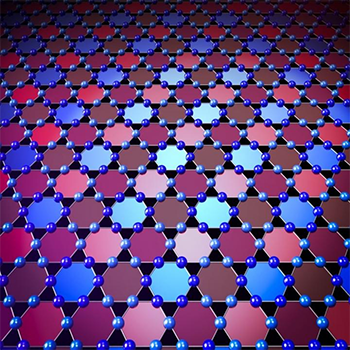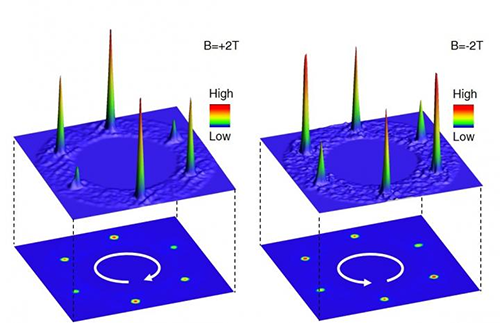| Jun 19, 2021 |
Research team discovers unexpected quantum behavior in kagome lattice
(Nanowerk News) An international team led by researchers at Princeton University has uncovered a new pattern of ordering of electric charge in a novel superconducting material.
|
|
The researchers discovered the new type of ordering in a material containing atoms arranged in a peculiar structure known as a kagome lattice. While researchers already understand how the electron's spin can produce magnetism, these new results provide insights into the fundamental understanding of another type of quantum order, namely, orbital magnetism, which addresses whether the charge can spontaneously flow in a loop and produce magnetism dominated by extended orbital motion of electrons in a lattice of atoms.
|
|
Such orbital currents can produce unusual quantum effects such as anomalous Hall effects and be a precursor to unconventional superconductivity at relatively high temperatures. The study was published in the journal Nature Materials ("Unconventional chiral charge order in kagome superconductor KV3Sb5").
|
 |
| Schematic of the new type of charge order seen in a kagome superconductor material with topological band-structure. The dark and light blue spheres form the kagome lattice, named for its resemblance to a Japanese woven basket pattern. The shade of the color represents the partial distribution of the charge. The distributed colors in the lattice illustrate the unexpected ordering pattern with chirality or handedness as determined by the experiment. (Image: Y.-X. Jiang, J.-X. Yin and M.Z. Hasan, Princeton University)
|
|
"The discovery of a novel charge order in a kagome superconductor with topological band-structure which is also tuneable via a magnetic field is a major step forward that could unlock new horizons in controlling and harnessing quantum topology and superconductivity for future fundamental physics and next-generation device research," said M. Zahid Hasan, the Eugene Higgins Professor of Physics at Princeton University, who led the research team.
|
|
The discovery's roots lie in the workings of two fundamental discoveries in the 1980's. One is the quantum Hall effect - a topological effect which has been the subject of decades-long research. The Hall effect was the first example of how a branch of theoretical mathematics, called topology, could fundamentally change how to describe and classify the matter that makes up the world. Important theoretical concepts on the quantized Hall effect were put forward in 1988 by F. Duncan Haldane, the Thomas D. Jones Professor of Mathematical Physics and the Sherman Fairchild University Professor of Physics, who in 2016 was awarded the Nobel Prize.
|
|
The second precedent was the discovery of the unconventional high-temperature superconductor which was the subject of the Nobel Prize in 1987. The unusual state of these superconductors has puzzled scientists. Important theoretical concepts on loop currents as a precursor of unconventional superconductivity were put forward in late 1990s by several theorists.
|
|
In both cases, the key proposal is that the charge can flow in a special lattice to produce effects like orbital magnetism. However, direct experimental realization of such a highly speculative type of electronic quantum charge order is extremely challenging.
|
|
"The realization of orbital current type charge order would require the materials to have both strong interactions and special lattice geometries that were realized only the last few years," said Hasan.
|
 |
| Magnetic field control of the chiral charge order. Changing the magnetic field (B) strength from +2T to -2T switches the chirality of the spectral peak (spikes in the data) ordering which represents the handedness of the underlying charge ordering pattern. (Image: Y.-X. Jiang, J.-X. Yin and M.Z. Hasan, Princeton University)
|
|
Through several years of intense research on several geometrical lattice systems (Nature 562, 91 (2018); Nature Phys 15, 443 (2019), Phys. Rev. Lett. 123, 196604 (2019), Nature Commun. 11, 559 (2020), Phys. Rev. Lett. 125, 046401 (2020), Nature 583, 533 (2020), Nature Reviews Physics 3, 249 (2021), the team gradually realized that kagome superconductors can host such topological-type charge order. Dozens of superconductors with kagome lattices have been discovered over the last 40 years but none showed the desired pattern.
|
|
One notable kagome superconductor is AV3Sb5 (A=K,Rb,Cs), which early experiments have shown to contain hints of a hidden order around 80 degrees Kelvin, making it a plausible platform for looking for the topological-type charge order.
|
|
"Superconductivity often suggests instabilities for the charge of the system, and the kagome lattice is known to be a frustrated lattice system," Hasan said. "The kagome superconductors can form various exotic charge orders, including the topological-type charge order related to their global band-structure. That led us to our search in this family, although it was not clear whether this superconductivity was unconventional when we started to work on this material."
|
|
The Princeton team of researchers used an advanced technique known as sub-atomic-resolution scanning tunneling microscopy, which is capable of probing the electronic and spin wavefunctions of material at the sub-atomic scale with sub-millivolt energy resolution at sub-Kelvin temperatures. Under these fine-tuned conditions, the researchers discovered a novel type of charge order that exhibits chirality - that is, orientation in a particular direction - in AV3Sb5.
|
|
"The first surprise was that the atoms of the material rearrange themselves into a higher-order (superlattice) lattice structure that was not expected to be there in our data," said Yuxiao Jiang, a graduate student at Princeton and one of the first co-authors of the paper. "Such a superlattice has never been seen in any other kagome system known to us."
|
|
The superlattice was the first hint to the researchers that there could be something unconventional in this material. The researchers further increased the temperature of the material to find that the superlattice disappeared above the critical temperature of the hidden phase estimated from the electrical transport behavior of the bulk of the material.
|
|
"This consistency gives us the confidence that what we observed is more likely to be a bulk ordering phenomenon rather than a surface effect," said Jia-Xin Yin, an associate research scholar and another co-first author of the study.
|
|
Hasan added, "For a bulk charge order, we need to examine further whether there is an energy gap and whether the charge distribution in the real space shows any reversal across the energy gap."
|
|
The researchers soon checked both points to confirm again that the unexpected charge order shows a striking charge reversal across the energy gap, which also disappears at the same critical temperature. The accumulated experimental evidence established that the researchers observed a charge order in a kagome material, which has never been reported in any other kagome system.
|
|
"Now we are in a position to ask the bigger question: whether it can be a topological charge order?" said Hasan.
|
|
Yin added, "Luckily, through our systematic research of geometrical lattice systems over recent years, we have developed a vector magnetic field-based scanning tunneling microscopy methodology to explore any potential topological feature of the material."
|
|
Fundamentally, the magnetic field applied on an electronic system leads to a nontrivial topology: the magnetic flux quantum (h/e) and quantum Hall conductance (Ne2/h, related to Chern number N, a topological invariant) are governed by the same set of fundamental constants, including the Planck's constant h and elemental charge e; the vector nature of the field can differentially interact with the chirality of topological matter to provide access to effects related to the topological invariant.
|
|
The researchers performed experiments on the charge order at zero magnetic field, a positive magnetic field, and a negative magnetic field. "Before the data was taken, we really didn't know what would happen," Hasan said.
|
|
Once the experiments were complete, Jiang said, the answer to the question of topological-like charge order was "yes."
|
|
"We found that the charge order actually exhibits a detectable chirality, which can be switched by the magnetic field," Jiang said.
|
|
The researchers are excited about their initial discovery. "Before the claim could be made, we still needed to reproduce this result multiple times, to rule out effects from the scanning probe, which may be extrinsic in nature," said Yin.
|
|
The researchers further spent several months to find that this magnetic field-switchable chiral charge order is ubiquitous in KV3Sb5, RbV3Sb5 and CsV3Sb5. "Now we are convinced that it is an intrinsic property of this class of material," Hasan added, "And that's very exciting!"
|
|
The magnetic field explicitly breaks time-reversal symmetry. Therefore, their observation shows that the chiral charge order in the kagome lattice breaks time-reversal symmetry. This is somewhat analogous with the Haldane model in the honeycomb lattice or the Chandra Varma model in the CuO2 lattice.
|
|
Researchers further identified the direct topological consequence of such chiral charge order. With the help of first-principle calculations of the band structure, the team found that this chiral charge order will produce a large anomalous Hall effect with orbital magnetism, which is consistent with the existing transport result which was interpreted differently in a previous work.
|
|
Now the theoretical and experimental focus of the group is shifting to the dozens of compounds with kagome lattice flatband properties and also superconductivity. "This is like discovering water in an exoplanet - it opens up a new frontier of topological quantum matter research our laboratory at Princeton has been optimized for," Hasan said.
|


